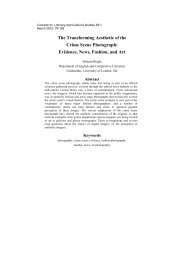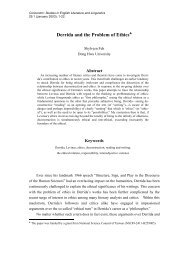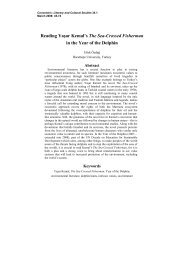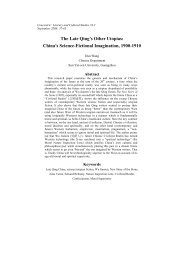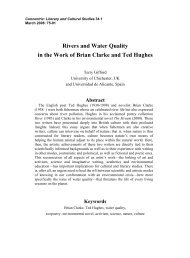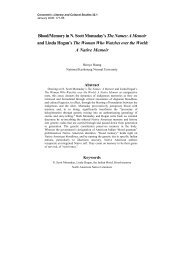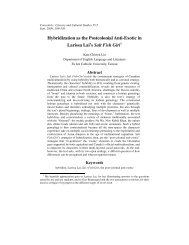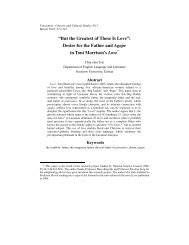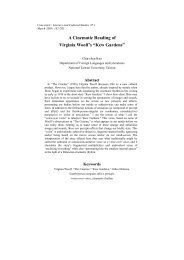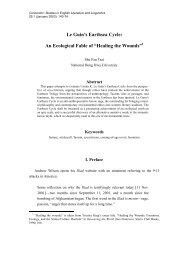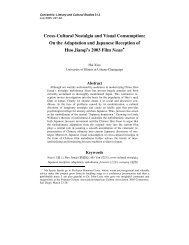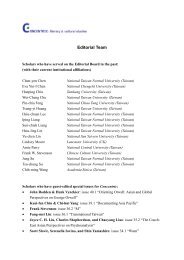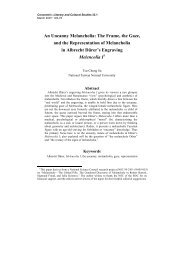Paranoid Designs: Toni Cade Bambara's Those Bones ... - Concentric
Paranoid Designs: Toni Cade Bambara's Those Bones ... - Concentric
Paranoid Designs: Toni Cade Bambara's Those Bones ... - Concentric
You also want an ePaper? Increase the reach of your titles
YUMPU automatically turns print PDFs into web optimized ePapers that Google loves.
<strong>Concentric</strong>: Literary and Cultural Studies 33.2<br />
September 2007: 149-75<br />
<strong>Paranoid</strong> <strong>Designs</strong>:<br />
<strong>Toni</strong> <strong>Cade</strong> Bambara’s <strong>Those</strong> <strong>Bones</strong> Are Not My Child<br />
Carl Gutiérrez-Jones<br />
University of California, Santa Barbara<br />
Abstract<br />
Bambara’s experimental novel, <strong>Those</strong> <strong>Bones</strong> Are Not My Child (1999),<br />
examines the African American community’s response to the Atlanta child<br />
murders of the 1970s and 1980s. With the abductions and pointedly inadequate<br />
institutional responses combining to provoke a powerful paranoia in<br />
the African American community, the issue of perception-under-siege itself<br />
becomes a crucial point of focus for community members in Bambara’s<br />
representation of the events. Bambara explores the ways that the community<br />
negotiates its experiences of paranoia, focusing on how community members<br />
respond to a crisis of interpretation as institutions that are charged to assist<br />
instead blame the victims and their parents for the murders. In this regard, the<br />
novel highlights, and adds to, an archive of cultural works that model the<br />
experience of paranoia and the steps necessary to gain a critical interpretation<br />
of paranoia when it is used as a means of racially-motivated social control.<br />
Engaging complex ethical issues, Bambara uses the style and content of her<br />
work to evoke a muted sense of paranoia in the reader at the same time that<br />
she provides models of homeopathic exposure to paranoia in the narrative.<br />
While Bambara takes an ethical risk when re-staging traumatic experiences of<br />
paranoia in characters and readers alike, these risks are balanced by the<br />
community’s ethical norms that justify an ongoing preparation for racist<br />
actions like those embodied in the as yet unsolved Atlanta murders.<br />
Bambara’s effort, in turn, has significant implications for current research on<br />
the literature of paranoia.<br />
Keywords<br />
African American community, African American literature,<br />
<strong>Toni</strong> <strong>Cade</strong> Bambara, child abduction, paranoia, racism, terror
150<br />
Gutiérrez-Jones<br />
<strong>Paranoid</strong> <strong>Designs</strong><br />
Fictionally reconstructing the Atlanta child murders of the 1970s and 1980s,<br />
in which more than 45 young African Americans were killed, <strong>Toni</strong> <strong>Cade</strong> Bambara’s<br />
<strong>Those</strong> <strong>Bones</strong> Are Not My Child (1999) foregrounds the battle that ensued between<br />
the city’s institutions and the African American community. 1 As Bambara<br />
emphasizes, the government institutions repeatedly accused, both implicitly and<br />
explicitly, the African American community of being paranoid when it perceived<br />
the attacks to be both interconnected, as well as poorly investigated. This<br />
interpretive battle, focalized primarily through the perspective of the African<br />
American community, is at the heart of the novel; a reading that highlights this<br />
dynamic can offer an important means of contextualizing many of Bambara’s<br />
narrative choices, including those that have been deemed weaknesses by some<br />
reviewers. Most importantly, this approach brings into focus Bambara’s interest in<br />
what may be termed “critical paranoia.” Specifically, the novel invites readers to<br />
identify with the experiences of paranoia described in the text, and in the process,<br />
Bambara proposes homeopathic possibilities that help one understand the ethical<br />
value of renegotiating injuries in literature, injuries that might be deemed too<br />
horrendous to “pass on,” as <strong>Toni</strong> Morrison suggests at the close of Beloved. As<br />
Bambara’s text makes clear, this potentially productive relation to paranoia evolves<br />
from a complex state of social interaction and interpretation developed in response<br />
to experiences of race hate, including psychological manipulation, that have a long<br />
history in Atlanta, and in the southern Unites States. 2<br />
Recalling that the Greek root for paranoia translates as “out of one’s mind,”<br />
we may read the representation, and solicitation, of critical paranoia in the novel as<br />
a pedagogical tool, as a means of thinking anew about institutions, kinship bonds<br />
and community agency. In this case, paranoia as a state of social interaction and<br />
interpretation offers a means of gaining a critical distance (stepping outside habits<br />
of thinking and feeling) while simultaneously embracing communal modes of<br />
interpretation that have been developed, in this case over hundreds of years, in<br />
response to white supremacist terrorism. <strong>Those</strong> <strong>Bones</strong> Are Not My Child is an<br />
excellent text for exploring such a revised sense of critical paranoia precisely<br />
because Bambara’s novel focuses attention on local, national and transnational<br />
struggles over paranoia. The novel also highlights a micropolitics not yet<br />
1 For a detailed recounting of the investigation, see The List (1984) by Chet Dettlinger and Jeff<br />
Prugh.<br />
2 For an excellent, multidisciplinary account, see Lynching in the New South: Georgia and<br />
Virginia: 1880-1930, by W. Fizthugh Brundage. The U.S. Senate also recognized this history in<br />
2005 when its members approved a resolution apologizing for the Senate’s failure to enact an<br />
anti-lynching law when it was first proposed more than 100 years ago.
Gutiérrez-Jones<br />
<strong>Paranoid</strong> <strong>Designs</strong><br />
151<br />
sufficiently registered in literary theories regarding paranoia. Bambara’s approach<br />
to paranoia discourages readers from pathologizing the individual or community<br />
caught up in the kinds of crises of interpretation represented in the novel. One may<br />
grant the existence of clinically-defined paranoia and yet note that clinical<br />
definitions have consistently replicated the very crises of interpretation associated<br />
with paranoia itself. 3 As an alternative to this too simple pathologizing, Bambara’s<br />
novel sheds light on paranoia as a social construct and as a rhetorical tool used by<br />
Atlanta’s media and legal establishment in order to discredit readings that might<br />
pose a challenge to the regime’s functioning, and to foster a sense of isolation<br />
among individuals who might choose a path of resistance. Manipulating paranoia as<br />
a strategy of social control, the media and legal establishment evoke in the African<br />
American community a crisis of interpretation, but one that is checked by an<br />
understanding of the community’s present historical and political circumstances. In<br />
this vein, the African American community’s response to the systematic attacks and<br />
the systematic denial of justice builds on past and present negotiations of terror, and<br />
on a collective experience of history.<br />
Bambara’s focus falls primarily on the African American community’s<br />
response to the attacks, both during and after the highly problematic “official”<br />
recognition of the terror by local government agencies and law enforcement.<br />
Although one survivor has begun the healing process by the novel’s close, Bambara<br />
emphasizes throughout the work the effects of the terror as these effects are<br />
perceived by the African American community. Bambara’s focus on the communal<br />
effects of terror is sufficiently strong here that the issue of perception-under-siege<br />
itself becomes a crucial point of concern for the African American community<br />
members as they rethink the lenses that they use to make sense of their world. In<br />
particular, Bambara is interested in how these community members respond to a<br />
crisis of interpretation as institutions that are charged to assist instead either accuse<br />
the African American community, and especially the parents, of harming their own<br />
children, or presume a neglect by the community that fosters child runaways and<br />
vagrants, a loaded accusation given that vagrancy laws were used by southern<br />
police departments after abolition as a means of reasserting social control over freed<br />
slaves and their descendants. 4<br />
3 Laplanche and Pontalis describe this struggle over definitions in The Language of<br />
Psychoanalysis (296). For a reading of why this interpretive battle tends to replicate features<br />
associated with paranoia itself, see Melley (17).<br />
4 My thanks to Bryan Wagner, who provided information regarding the creation of the Atlanta<br />
Police Department, material that will be part of his forthcoming book.
152<br />
Gutiérrez-Jones<br />
<strong>Paranoid</strong> <strong>Designs</strong><br />
While the readerly identification with the fictional African American family at<br />
the center of the story is predictably strong, Bambara invites her audience to rethink<br />
these readerly attachments. In this regard, she presents the larger community’s<br />
understanding of its ethical commitments, and the structuring of its agency, as a<br />
model to be engaged, possibly even emulated, by readers. Contributing to this goal,<br />
the polyphonic quality of the narration, often noted in responses to the novel, invites<br />
readers to think of the community members, and their families, as mutually<br />
constituting one another. This polyphonic quality certainly presents a challenge to<br />
readers who must labor with some care to track the various characters and their<br />
roles as Bambara weaves their voices together. While the polyphonic narrative<br />
voice emphasizes the community as an agent, Bambara also strategically<br />
incorporates this complex voice in order to solicit in her readers a muted crisis of<br />
interpretation; this crisis, in turn, relates to that experienced by characters<br />
overwhelmed by information and contending with institutions eliciting paranoia.<br />
This essay begins by exploring theories regarding paranoia as a central issue<br />
animating contemporary U.S. fiction. In the process, the essay explores the<br />
potentials and limitations of these theories when they are placed in conversation<br />
with the literature of racialized communities. The focus then shifts to questions of<br />
group and institutional agency, probing notions regarding paranoia as these are<br />
attached to, and critically reworked by, communities, such as that represented by<br />
Bambara. Bambara suggests that victimized communities have been constituted by<br />
“passing on” a developing genealogy of critical reading practices from one<br />
generation to the next; these practices include critical approaches to the paranoia<br />
promoted by a long line of institutions premised on, or infected by, white<br />
supremacist ideology. With this genealogical process charted, the focus of the essay<br />
then moves to Bambara’s complicated engagement with, and resistance to, narrative<br />
closure. This issue of closure, a dominant thematic element in the novel, is read in<br />
light of the failings by the government agencies to address the attacks on the<br />
African American community (failings that continued to make national news in<br />
2005 as Atlanta decided to reopen the investigation regarding the child murders),<br />
but also in light of the imagined family’s and community’s potentially problematic<br />
desire to transcend the terrorism by retreating into a pointedly inadequate<br />
explanation of the murders, and into a prior, supposedly safer world defined by<br />
greater individual autonomy. The refusal to claim the bodily remains announced in<br />
the title of the work thus becomes an occasion to explore the relationship between<br />
paranoia, judgment, mourning and premature closure. Ultimately, the argument<br />
presented here invites readers to approach <strong>Those</strong> <strong>Bones</strong> Are Not My Child as a
Gutiérrez-Jones<br />
<strong>Paranoid</strong> <strong>Designs</strong><br />
153<br />
carefully crafted novel that strategically and experimentally analyzes embattled<br />
manipulations of paranoia, where paranoia is understood both as a means of social<br />
control, and in its critical, alternative form, as an opportunity for gaining a more<br />
incisive understanding of institutional dynamics, collective agency and the politics<br />
of interpretation.<br />
Theorizing Paranoia, Engaging Race<br />
Bambara constructs <strong>Those</strong> <strong>Bones</strong> Are Not My Child through a series of<br />
snapshots—explicitly demarcated days in the life of its central characters, the most<br />
prominent of whom is Marzala Rawls Spencer. Extending from July 20, 1980, to<br />
July 8, 1987, this series begins in media res insofar as the terror campaign is<br />
concerned. Similarly, the prologue is chronologically situated at a midpoint of the<br />
action recounted in the novel, fifteen months after the abduction of Marzala’s son.<br />
As a result, these “beginnings” convey both urgency and a retrospective struggle as<br />
Marzala, her estranged husband, Nathaniel (“Spence”) Spencer, and fellow<br />
community members undertake a desperate search for missed clues or connections<br />
that might help them locate her oldest child, Sundiata (“Sonny”), who has<br />
disappeared during a Boy’s Club outing. The earliest dates in this temporal series,<br />
the dates coinciding with Sonny’s abduction, find Marzala both fearful of, and in<br />
denial regarding, the terror campaign targeting Atlanta’s African American children.<br />
When Marzala does begin the demeaning and frustrating effort to gain assistance<br />
from the police, Bambara suggests that her initial denial is itself problematic<br />
because Marzala has not previously helped others in the community who were<br />
already contending with the attacks and similarly inadequate assistance from police.<br />
Contextualizing Marzala’s responses during the early stages of Sonny’s<br />
abduction, Bambara invites readers to focus on issues of collective agency and<br />
isolation in the prologue. Here, readers find Marzala enraged by police incompetence<br />
and inaction, in part because no progress has been made in locating Sonny,<br />
and in part because the city “too busy to hate” has settled on a scapegoat—a local<br />
African American named Wayne Williams—and announced that the terror<br />
campaign is over (a claim betrayed by continuing abductions and murders). Several<br />
features stand out immediately as one considers this prologue. Foremost is the<br />
palpable tension that Bambara creates between Marzala’s desire to gain information<br />
and her fear of being discounted as paranoid. Bambara introduces this tension as<br />
readers first encounter Marzala obsessively sweeping her front porch, an action that<br />
allows her to camouflage her “sweeping” visual surveillance of the neighborhood.
154<br />
Gutiérrez-Jones<br />
<strong>Paranoid</strong> <strong>Designs</strong><br />
The struggle, between the desire for information and the fear of asking in a way that<br />
will be misread, is modeled repeatedly in the prologue, as Marzala poses well-worn<br />
questions to Sonny’s school friends, and as Marzala calls Sonny’s school to see if<br />
any news had been gained there. In addition to her concerns about being perceived<br />
as a legitimate and sane actor, Marzala also reveals a fear of being held responsible<br />
for Sonny’s disappearance, in large part the result of police attempts to silence the<br />
African American community groups (which have desperately sought media<br />
attention) by inviting suspicion of the parents. Most fundamentally, the prologue<br />
conveys Marzala’s sense of growing isolation, a strong indicator that institutional<br />
attempts to drive her into uncritical paranoia have had an effect. At the same time,<br />
the diversion provided by the Wayne Williams case weakens the community-based<br />
organizations responding to the terror campaign, leaving people like Marzala with<br />
diminished recourse to a collective agency that has constituted their only real hope.<br />
Bambara’s exploration of paranoia (foregrounded in her Prologue), and her<br />
elaboration of how Atlanta’s African American community at times reworks<br />
paranoia for critical, homeopathic purposes, stand in contrast to the most prominent<br />
theories regarding the representation of paranoia in literature. These theories<br />
strongly, at times exclusively, emphasize an individualistic, nostalgic drive in<br />
narratives about paranoia. <strong>Those</strong> <strong>Bones</strong> Are Not My Child presents an invitation to<br />
rethink these theories of literary paranoia in light of counter-examples: texts that<br />
analyze collective social marginalization and offer a more nuanced approach to the<br />
interpretive battles engaged. Rather than simply reproducing the pathological<br />
symptoms associated with paranoia, such texts combine a sense of living in terror,<br />
and a sense of living with a critical understanding of paranoia-as-social-control,<br />
including the systematic delegitimation of African American analyses that would<br />
“connect the dots,” and thereby reveal varying degrees of institutional complicity in<br />
racist violence and psychological manipulation. 5 A number of rich critical studies<br />
treating paranoia in contemporary literature have been published in recent years;<br />
looking more closely at these treatments, Bambara’s readers will find important<br />
opportunities to complicate understandings of paranoia and the socio-historical<br />
engagements of the literature. 6 In particular, a dialogue between these studies and<br />
5 For a reading of the ways in which the legal system undermines the recognition of race hate<br />
crimes by focusing narrowly on limited notions of perpetrator and victim, thereby avoiding<br />
questions of complicity involving bystanders, collaborators and other actors, see Gutiérrez-<br />
Jones’s Critical Race Narratives (1-17). Novels that work in the fashion described include<br />
Ishmael Reed’s Mumbo Jumbo, <strong>Toni</strong> Morrison’s Beloved, Alejandro Morales’s The Brick People,<br />
and Louise Erdrich’s Tracks.<br />
6 My survey focuses on three works examining paranoia and contemporary literature: Leo
Gutiérrez-Jones<br />
<strong>Paranoid</strong> <strong>Designs</strong><br />
155<br />
Bambara’s novel provides an occasion for considering the difference that race can<br />
make when analyzing the literature of paranoia.<br />
According to Merriam-Webster's Medical Dictionary (2002), paranoia is<br />
defined as a psychosis characterized by systematized delusions of persecution or<br />
grandeur usually without hallucinations, and as a tendency on the part of an<br />
individual or group toward excessive or irrational suspiciousness and distrustfulness<br />
of others. Mental illness, in the broad sense, had been described as paranoia<br />
until the late 1800s when physicians circumscribed its definition and distinguished<br />
paranoia from various forms of dementia. Generally speaking, this distinction<br />
signaled an apparent difference in terms of the patient’s connection with reality.<br />
While patients exhibiting paranoia in this schema could show signs of dementia<br />
(including a disconnection from the world around them), these patients would<br />
typically construct interpretations and fantasies by drawing from a wealth of<br />
verifiable details, doing so in highly systematic ways. According to this theory, part<br />
of what typifies the patient with paranoia is the patient’s ability to integrate his or<br />
her fantasy life with reality.<br />
Freud made significant contributions to the ongoing debates about paranoia,<br />
particularly in his work on Daniel Paul Schreber. 7 For Freud, cases like Schreber’s<br />
afford a glimpse into the most fundamental processes of psychic life and<br />
development because the symptoms are driven by basic psychological impulses<br />
(Gilman 135). In particular, Freud saw in paranoia a rebellion against external<br />
(social) prohibitions that have been internalized in the formation of the ideal ego<br />
(what he came to term the superego in his later work). In this sense, the patient with<br />
paranoia is rebelling against his or her own inner monitor, which may manifest as<br />
voices or plots conspiring against the patient, forces that seem to be external to the<br />
patient. Freud also claimed that paranoia was a defense against homosexuality,<br />
because he saw the ideal ego as being strongly fed by libidinal energies of a<br />
homosexual nature. Although Freud was not explicit on this matter, his writings<br />
suggest that the ideal ego (and internal monitoring function) had this homosexual<br />
charge because a) loving oneself is, technically speaking, a homosexual kind of<br />
love, and b) given that the formation of the ideal ego is prompted by prohibitions<br />
drawn from the social context, the expression of same sex desire is funneled into the<br />
ideal ego where it may be “safely” addressed (Laplanche and Pontalis 297).<br />
Bersani’s “Pynchon, Paranoia and Literature,” Timothy Melley’s Empire of Conspiracy, and<br />
Patrick O’Donnell’s Latent Destinies.<br />
7 See Freud’s “Psycho-Analytic Notes on an Autobiographical Account of a Case of Paranoia<br />
(Dementia <strong>Paranoid</strong>es),” and Schreber’s Memoirs of My Mental Illness.
156<br />
Gutiérrez-Jones<br />
<strong>Paranoid</strong> <strong>Designs</strong><br />
What is particularly important about definitions of paranoia, in light of these<br />
origins, is the close association the condition is presumed to have vis-à-vis social<br />
reality. According to Freud, paranoia arises from what are otherwise normal psychic<br />
processes (self-monitoring), and appears to transfer the critical monitoring function<br />
to an external source; this transfer, in a sense, brings patients full circle since<br />
according to Freud the prohibitions that have been internalized in the formation of<br />
the ideal ego were of an external social origin from the beginning. In sum, paranoia<br />
stands out as a concept that may deeply trouble the categorical distinction between<br />
normative, healthy behavior, and pathological manifestations, precisely because the<br />
concept emphasizes the interface between psychic and social life. As a corollary,<br />
one may consider Freud’s efforts to establish psychoanalysis, and the reality of<br />
“deep psychic processes” based on interpretations of dream material and the like, as<br />
an extended struggle against being read as paranoid (Melley 24).<br />
Freud succeeded in founding this science, but as Sander L. Gilman has<br />
demonstrated in Freud, Race and Gender (1995), when examined closely, Freud’s<br />
work evinces a complex negotiation with the anti-semitism that was pervasive in his<br />
social context, and among his medical peers. One result of this negotiation was that<br />
Freud, when analyzing patients like Schreber, avoided pronounced racial material<br />
and displaced this evidence by emphasizing “universal” psychic structures, for<br />
example the Oedipal complex (Gilman 143-45). Based on the displacement of antisemitism<br />
carefully documented by Gilman, we may surmise that Freud expended<br />
considerable energy in order to avoid racial controversies that, during his day, might<br />
have led many of his peers to discount his work. Given the prevailing assumption of<br />
the time, that people of Jewish descent were more inclined to develop mental illness,<br />
and the assertion by many of Freud’s contemporaries that this propensity was a<br />
result of tribal inbreeding, it is not difficult to see why Freud would be concerned<br />
that his work could become a lightning rod if it pressed a critique of anti-semitism.<br />
But while the prevailing racial attitudes may have deterred Freud from more<br />
thoroughly developing the interplay of race and paranoia, he did acknowledge in a<br />
more general fashion that patients diagnosed as paranoid could truly be subject to<br />
threats and conspiracies: that their expressions of paranoia might be mixed in<br />
complex ways with real, socially-based, systematic efforts to harm the patient.<br />
Overall, the complex negotiation between social and psychic factors that come<br />
together in the concept of paranoia help explain why the term’s definition is<br />
continually being contested within the medical establishment, provoking a crisis of<br />
interpretation that more than one commentator has likened to the interpretive battles
Gutiérrez-Jones<br />
<strong>Paranoid</strong> <strong>Designs</strong><br />
157<br />
identified with paranoia itself (Melley 17). 8<br />
Although some of the most notable attempts to define paranoia in a larger<br />
social context have emphasized the condition as a clear cut pathology—Richard<br />
Hofstadter’s The <strong>Paranoid</strong> Style in American Politics (1965), for example--one<br />
tends to find in more recent treatments a more sophisticated acknowledgement of<br />
the tensions that the psychoanalytic concept of paranoia creates for any categorical<br />
distinction between reality and fantasy (Melley 23).<br />
All the same, these more recent studies, including those engaging literature,<br />
focus almost exclusively on the limitations of paranoia as a mode of apprehension<br />
and interpretation. A quick survey of the literary studies reveals certain dominant<br />
findings. First, paranoia as engaged in the post WWII U.S. fiction is posed as a<br />
fundamentally nostalgic gesture (Melley 33). A response to a sense of self that is<br />
thoroughly compromised by corporate influences and media saturation, paranoia in<br />
these fictional texts is most often a means of reasserting an unfettered notion of the<br />
individual agent drawn from the past (Melley 6, 25). This nostalgic impulse,<br />
highlighted in Leo Bersani’s frequently cited essay on paranoia and Thomas<br />
Pynchon’s Gravity’s Rainbow, has been reworked in rich and varied ways in<br />
subsequent treatments of the topic, yet this fundamental notion regarding a retreat<br />
from the present (and future) remains an abiding feature of the critical reception<br />
(Bersani 109; O’Donnell 1-10). Second, theorists have assumed that anxieties<br />
regarding the compromised self, what Timothy Melley calls “agency panic,” harbor<br />
a desire for a male privilege that can resist the all-encompassing, feminine sameness<br />
of paranoia inspiring conspiracies and systems (Melley 32). According to these<br />
studies, the fictional paranoid, as well as the fiction of paranoia, most often records<br />
a desire to reassert the (potentially phantasmatic) masculine privilege of a bygone<br />
era. Not surprisingly perhaps, the “canon” of authors most often cited in such<br />
studies is predominantly male. All of these studies assume that an embattled sense<br />
of the individual self is a primary locus of concern for most of the authors treated.<br />
While these studies generate powerful readings of the dynamics noted, they<br />
tend to miss the productive tension between the individual and society that Freud’s<br />
theory of paranoia registered, even as Freud simultaneously downplayed this<br />
tension, and especially racial factors, by making the interpretive focus of his<br />
psychoanalysis the individual patient’s negotiation of universal psychic structures<br />
and processes. One consequence of Freud’s response to his social context (his<br />
8 Se also Gilman’s account of the ways in which psychoanalysis was initially discounted as the<br />
product of Jewish mentality that was presumed itself to be inclined toward mental illness (30-31,<br />
106).
158<br />
Gutiérrez-Jones<br />
<strong>Paranoid</strong> <strong>Designs</strong><br />
deferral of anti-semitism while interpreting Schreber’s paranoia) is that a model of<br />
avoidance has been passed along to subsequent theorists. The point here is not to<br />
dismiss the debilitating effects of what has been designated clinical paranoia, but<br />
rather to suggest that the embattled definitions of the phenomena are a product of<br />
the social context that they inhabit. The social forces that shaped the concept of<br />
paranoia were very much affected by racial dynamics even as the concept was<br />
constructed to limit recognition of these dynamics. Freud was invested in this<br />
inquiry about paranoia precisely because he understood its deep relevance to<br />
“normal” psychic functioning.<br />
Many of the literary authors who have been the focus of studies on post-<br />
WWII paranoia have been read as examples of the nostalgic, individualistic<br />
impulses noted, and these authors have been, implicitly and explicitly, offered as<br />
representative of U.S. literary ventures with paranoia. By contrast, even a cursory<br />
review of literature about racialized communities produces a host of rich yet<br />
neglected examples interrogating paranoia (including Ralph Ellison, <strong>Toni</strong> Morrison,<br />
Ishmael Reed, Louise Erdrich, Alejandro Morales). This writing tends not to be<br />
included in the lists of paranoia-focused authors, which frequently looks a great<br />
deal like the post-modernist canon. One reason for this pattern may be that the<br />
protagonists of the authors conventionally associated with exploring paranoia are<br />
more easily read as individuals and more easily isolated from their social contexts<br />
because they are often white and male and therefore frequently enjoy a greater<br />
degree of enfranchisement and autonomy than many of their female and raced<br />
counterparts. By reproducing the social norm of individualism, critical studies that<br />
focus primarily on characters exercising white male privilege displace struggles<br />
regarding the legitimacy of social groups and collective action, struggles that are<br />
fundamental for winning reparations, and enforcing policies and laws that would<br />
address the legacy of racism in the United States. 9<br />
Among the critical studies devoted to paranoia, Timothy Melley’s Empire of<br />
Conspiracy: the Culture of Paranoia in Postwar America (1999) is the most<br />
successful in terms of engaging questions regarding group agency. While asserting<br />
the primacy of the nostalgic impulse in many paranoid texts, Melley describes<br />
several of Margaret Atwood’s novels as achieving a uniquely self-conscious and<br />
critical paranoia (110). Here, Melley reads Atwood’s feminist critique of marriage<br />
as a patriarchal institution as a politically charged engagement with the present, and<br />
9 Melley wrestles with this problem in a very provisional manner when he argues that literary<br />
approaches to paranoia appear to “flatten” social experience (and therefore analyses of race) but<br />
also offer the possibility of innovative social analysis (10-11).
Gutiérrez-Jones<br />
<strong>Paranoid</strong> <strong>Designs</strong><br />
159<br />
as an action undertaken on behalf of women in general (123-32). The chapter on<br />
Atwood, a particularly rich part of Melley’s study, raises a number of questions<br />
because it recognizes the ways in which versions of critical and uncritical paranoia<br />
(i.e., those registering a more complex sense of social interaction, and those<br />
reproducing the nostalgic, individualistic drive exclusively) can contest one another<br />
within a single fictional work. Taking into account the subtle approach offered by<br />
Melley in his reading of Atwood—a reading that mines the social complexity of<br />
paranoia alluded to by Freud—we might well ask if there is also a greater concern<br />
with collective agency than has been heretofore acknowledged in the “canonical”<br />
postmodern texts. In what ways might these canonical texts be said to draw on<br />
collective agency and cultural traditions as a counter to the nostalgic individualism<br />
that they thematize Might literature focusing on race dynamics, as well as texts<br />
focusing on the experiences of other marginalized social groups, evince the kind of<br />
critical paranoia attributed to Atwood As Bambara’s novel suggests, one may also<br />
rethink the interaction of paranoia and race in texts that foreground inquiries<br />
regarding institutions, such entities understood not simply as a threat to self, but<br />
also as a loci of will and desire in themselves. With these issues in mind, we turn to<br />
Bambara’s novel in order to explore its collective, critical analysis of paranoia, an<br />
analysis that undertakes, first of all, rigorous self-examination (of the individual and<br />
group), thereby halting the problematic transference of the “monitoring function” to<br />
an external entity, and, at the same time, mining of a cultural archive conveying<br />
strategies for negotiating actions imposed from without, and intended to create a<br />
paranoid response.<br />
An Archive for Contending with Terror<br />
While several commentators have noted the emphasis on African American<br />
oral, musical and manuscript traditions in this novel, especially in the novel’s<br />
epilogue and prologue, important critical connections remain to be made regarding<br />
these features and an understanding of Bambara’s larger strategy with the novel<br />
(Taylor 261-63; Bone 233). Specifically, these traditions constitute for Bambara a<br />
developing critical genealogy: an archive with the ability to teach community<br />
members how best to read and respond to this and other campaigns of terror. 10 This<br />
10 The Taylor essay argues that the community develops alternative means of organizing and<br />
analyzing information and she focuses in particular on the creation of an archive that can serve<br />
pedagogical and politically-resistant functions (7-12).
160<br />
Gutiérrez-Jones<br />
<strong>Paranoid</strong> <strong>Designs</strong><br />
rhetorical and pedagogical goal helps explain why Bambara took certain risks with<br />
the narrative. Foremost among these risks, at least judging by the initial responses<br />
to the novel, is Bambara’s decision to displace the Spencer family as a point of<br />
focus for significant portions of the novel. This attenuation is achieved through a<br />
number of techniques, most obviously by incorporating various alternative plot<br />
lines and by recounting at length the information regarding the abductions gathered<br />
by the family and community.<br />
When such priorities dominate the narrative, readers can find themselves<br />
longing for reentry into the familial conflicts and for the closure that could come<br />
with the solving the mystery behind Sonny’s abduction. Some responses to the<br />
novel have suggested that the extended incorporation of these additional plot lines<br />
and documentary elements weakens the work, that Bambara might well have<br />
removed these parts in order make the family focus, and therefore the novel as a<br />
whole, stronger (Benjamin 340; Birkerts 17). While it is apparent that <strong>Those</strong> <strong>Bones</strong><br />
Are Not My Child tests readerly expectations, it does so strategically. If the<br />
reuniting of the family constitutes the hope that keeps many readers motivated, the<br />
offering of this hope is a means, not an end in itself. Bambara once described her<br />
short stories as functioning something like a Trojan horse; the same may be said of<br />
this novel. 11 With <strong>Those</strong> <strong>Bones</strong> Are Not My Child, Bambara’s goal is to facilitate a<br />
partial transfer of the affect readers have for family to Atlanta’s African American<br />
community as a whole, and to a degree, to similarly positioned international<br />
communities (including, for example, the social groups in Latin America and South<br />
Africa studied by the Atlanta volunteer groups investigating the murders).<br />
This strategy contextualizes Bambara’s decision to focus on Marzala’s initial<br />
impulse to withdraw from the community struggle once Sonny is found, and why<br />
this desire to separate as an individual (and as a discrete family) is ultimately<br />
superseded by Marzala’s renewed commitment to the community’s volunteer efforts.<br />
Bambara explicitly ties Sonny’s, and his family’s, prospects for recovery to their<br />
integration into the community’s agency and collective history. At the end of the<br />
work, two actions reinforce this drive toward integration. In these final pages,<br />
Marzala speaks at a rally organized to fight for a reopening of the official<br />
investigation, and this address includes a demand that community members be<br />
granted more direct access to testimony and information (660-64). In these same<br />
pages, a community network, including Marzala and Spence, carries out its own<br />
raid of a home used by Sonny’s abductors. Crucially, the description of the raid<br />
11 See Elliott Butler-Evan’s analysis of Bambara’s short stories and her interview with Claudia<br />
Tate regarding her strategies.
Gutiérrez-Jones<br />
<strong>Paranoid</strong> <strong>Designs</strong><br />
161<br />
ends without providing answers as to who was involved in the crimes, nor is the<br />
reader provided motives for the abductions and murders. Instead, the emphasis falls<br />
on the “in-process” action taken by the community as represented by Bambara.<br />
Giving detailed attention to these processes, Bambara highlights the sharing of<br />
knowledge about paranoia and its debilitating effects. For example, having<br />
struggled to gain national attention for the investigation of the attacks, the<br />
community groups find themselves the recipients of letters from across the country,<br />
including pleas for help and offers of advice and information. Working as a<br />
volunteer for the Committee to Stop Children’s Murders (STOP), Marzala<br />
encounters a letter from a mother of an abducted and recovered child. This letter<br />
acts as a warning, inasmuch as the author conveys how her connections to those<br />
around her were destroyed while she agonized for her child’s return.<br />
There’d been a mother who’d written from New Hampshire that it<br />
wasn’t until her baby girl was returned three years later—plump,<br />
cheerful, her ABCs and a few numbers in her repertoire—that she<br />
acknowledged the disintegration around her. Her husband had become<br />
a drunk. Her older daughter was suffering from double vision<br />
and malnutrition. Her son was withdrawn, had failing grades and a<br />
juvenile record. The mother had collapsed. (336-37)<br />
This mother’s story resonates in pointed ways with Marzala’s experience. At the<br />
beginning of the novel, she is so overwhelmed by Sonny’s disappearance that she<br />
neglects her youngest daughter, Kenti, leaving her unattended and vulnerable in a<br />
manner that brings censure from another parent. Many other scenes document the<br />
deteriorating communication within the family.<br />
In such episodes, Bambara conveys a crucial lesson regarding paranoia: one<br />
debilitating effect of the abductions is often social isolation experienced by the<br />
individuals within the community. The strategic “disappearance” of people, most<br />
notably as practiced by military regimes, is premised on similar assumptions. The<br />
police in Atlanta contributed to this effect by refusing to acknowledge the terror<br />
campaign in its initial stages, then by devising a list of victims that was<br />
fundamentally inadequate, thereby attempting to divide the families of the different<br />
victims, a fact that Bambara underscores as Sonny’s case falls outside of the<br />
officially recognized criteria for inclusion. 12 The media add to this sense of iso-<br />
12 For an analysis of the battles that ensued over these criteria during the investigation, see The<br />
List.
162<br />
Gutiérrez-Jones<br />
<strong>Paranoid</strong> <strong>Designs</strong><br />
lation during much of the terror by burying the coverage of the abductions and<br />
murders, or by avoiding the topic altogether, a point emphasized by Bambara in the<br />
novel when she describes Marzala’s younger son, Kofi, as stunned to find the news<br />
of the child murders treated with such disregard (57).<br />
Analyzing this “blackout,” Marzala and others in the novel attribute the local<br />
media’s response to a protection of Atlanta’s convention income and what Martyn<br />
Bone has described as Atlanta’s global capitalist identity, an abstraction that<br />
facilitates the city’s continuing success as the most profitable convention host in<br />
North America, even as it grimly erases the local body politic in a grotesque<br />
performance epitomized by the abductions themselves (Bambara 151-52, 230).<br />
Noting the role of the national media, Bambara offers an exchange between<br />
Marzala and a network newsman who provides two rationales for the exclusion:<br />
black kids dying in the South is old news, and terror is something that happens<br />
overseas (274). Taken together, the police and media responses amplify the sense of<br />
isolation produced by the abductions. To a significant degree, Bambara’s focus is<br />
this amplification as much as it is the abductions themselves. Although they<br />
struggle with a sense of isolation throughout the text, the Spencer family and the<br />
community do not succumb to it. Instead, they join volunteer community<br />
organizations to do the work of the government institutions that have failed them.<br />
A crucial part of the foundation for such action is the memory of community<br />
activism. These memories frequently recall previous periods of community action<br />
and resistance. As such, they counter the isolation associated with uncritical<br />
paranoia, and act as conduits redirecting the affect of the Freudian paranoia scenario<br />
(the anxiety for the isolated self and the fear of the omnipotent other) toward a third<br />
entity: kinship within the community of one’s peers. In this vein, Marzala recalls<br />
how she, as a child, assisted civil rights groups by painting over roof top markings<br />
made by the FBI in order to coordinate helicopter surveillance of activists. The<br />
success of such collaborative efforts also depends on establishing trust across class<br />
barriers, a prerequisite for action that contextualizes one of the more pronounced<br />
chronological leaps in the text. As Spence attempts to coax information from an<br />
unfamiliar, lower class African American mechanic who is danger because he has<br />
witnessed an abduction, the narrative thrusts the reader into Spence’s memory, to an<br />
episode in which his uncle Rayfield first introduced Spence to his poor country<br />
relations. This recollection stands out because of Spence’s embarrassment regarding<br />
his awkward initial reaction to his backwoods relatives, and because his reaction<br />
garnered his favorite uncle’s enraged disapproval. In the present of the novel—the<br />
period of the abductions—this link to the past provides a context for Spence’s
Gutiérrez-Jones<br />
<strong>Paranoid</strong> <strong>Designs</strong><br />
163<br />
awkwardness as he confronts the class line. This episode also situates a phrase<br />
repeated in the text, and attributed to uncle Rayfield—“memory is hope” (145).<br />
Ultimately, Bambara incorporates this jarring turn in her narrative in order to<br />
underscore the need to extend understandings of kinship, and in so doing, she<br />
emphasizes the value of memory and of a sense of history. The foundations of the<br />
archive—memory and history—stand as resources when people like Spence and<br />
Marzala must find a way to trust others within the volunteer organization despite<br />
the fear and suspicion that the city’s institutions would foster within the African<br />
American community.<br />
Witnessing and Testimony:<br />
Negotiating a Crisis of Interpretation<br />
As Carole Anne Taylor has noted, the archive presented by Bambara is above<br />
all a collection of community stories that are rarely granted legitimacy by society’s<br />
institutions. Marzala considers these stories carefully as she collects them, and<br />
while she is certainly deeply invested in seeking out those which will be most<br />
useful in solving the murder cases, she is also keenly aware of how the stories<br />
themselves fulfill a social function in the community, establishing a matrix for<br />
collecting, organizing and conveying ideas and feelings generally. This awareness is<br />
especially noteworthy immediately after the bombing of the Gate City Day Nursery<br />
in the Bowen Homes project. A sustaining feature of the community, this network of<br />
stories is posed as an important and complicated resource by Bambara when the<br />
community is confronted by traumatic events like the nursery explosion, which<br />
takes the lives of five people, including four very young children (297-98). This<br />
alternative archive incorporates a range of explanations for events like the bombing,<br />
and while the novel does not suggest that these stories are presented in order to<br />
legitimate one particular version, it does suggest that the stories are circulated so<br />
that they might be tested against community norms that are grounded in historical<br />
knowledge and experience. As such, community witnessing through storytelling<br />
constitutes a monitoring function that is analogous to the ideal ego formation<br />
described by Freud. This type of function is what Marzala helps Sonny to<br />
reinvigorate once he is back with his family, Bambara describing his “treatment” as<br />
a matter of learning to tell his own story (519). Bambara’s analysis of storytelling<br />
also suggests that readers—to the extent that they are traumatized by this recounting<br />
of the murders and their effects—may find hope in the archiving process to which<br />
the novel itself contributes. In sum, Bambara’s meditations on storytelling invite
164<br />
Gutiérrez-Jones<br />
<strong>Paranoid</strong> <strong>Designs</strong><br />
readers to view the novel as a form of collective testimony and witnessing<br />
responding to the paranoia that the terror campaign promoted.<br />
With so many of the abducted children in Atlanta ultimately murdered,<br />
Bambara prompts readers to consider carefully why she would choose to have the<br />
Spencer family in the relatively unique position of recovering their son. Perhaps<br />
most strikingly, Sonny’s reintroduction into the narrative offers a lesson regarding a<br />
primary effect of his kidnapping, inasmuch as “Sonny was taught fear” (564). In<br />
addition, Sonny’s recovery gives Bambara an opportunity to draw a parallel<br />
between his and the community’s response to the abduction. It is not simply that<br />
Sonny’s injuries have rippled out into the empathetic community, although the<br />
novel suggests this is true. Instead, Bambara strives to detail the complicated and<br />
diverse ways that the media and legal establishment foster fear in Atlanta’s African<br />
American community. Making the parents highly visible suspects, and demanding<br />
privacy-invading lie detector tests from them, promotes a fear that is explicitly<br />
associated in the novel with the desire by the legal institution to stifle community<br />
activism, and to silence criticism of law enforcement (185-89, 660). While Bambara<br />
describes an array of institutional practices that function in this manner, two<br />
techniques receive notable priority: the government’s opportunistic use of the crisis<br />
to justify spying on African American activist organizations, and the manipulation<br />
of strategically leaked “secret” information that heightens the sense of institutional<br />
agency at the expense of the community. While such leaks sometimes misdirect the<br />
STOP committee and other volunteer groups, the greater impact emphasized by<br />
Bambara involves the radical undermining of any trust that the groups might place<br />
in law enforcement or other government agencies.<br />
Although the official police task force receives frequent generalized attention<br />
in the text, only two figures within the legal establishment are developed in a<br />
sustained manner: Detective B. J. Greaves, who fights within the police department<br />
for recognition of the terror campaign and who offers initial encouragement to<br />
Marzala; and Judge Webber, who becomes a crucial, if cryptic, source of<br />
information regarding the cases over the course of the novel. What is most striking<br />
in these characterizations is how utterly difficult it is for these figures to negotiate<br />
their highly complicated political contexts. In both cases, their access to information<br />
and their position in the system of power is so tenuous that they are imbued with a<br />
distrust of institutions strongly mirroring that experienced by the parents. As<br />
Bambara notes in the text, the Atlanta Police Department of the time was<br />
constituted by two separate power structures, an older department run by whites,<br />
and complete with remnants of white supremacy, and a younger, largely African
Gutiérrez-Jones<br />
<strong>Paranoid</strong> <strong>Designs</strong><br />
165<br />
American department wrestling for power and reform (19). Bambara captures this<br />
intensely vexed political context in broad strokes, and this understanding is always<br />
working in the background as Bambara documents in significant detail numerous<br />
police actions related to the terror campaign. These actions, in the best spirit, would<br />
be termed incompetent, for example, discounting witnesses with unique and<br />
verified knowledge of the abductions and murders, as well as seriously mishandling<br />
crime scenes. Particularly disturbing in this regard is the mistreatment of the murder<br />
victims’ remains, or “those bones” (361, 370).<br />
Despite the detailed description of certain police actions, Bambara is more<br />
interested in how the African American community is perceiving the legal<br />
establishment than in that establishment’s comprehensive workings. The novel does<br />
not engage the process of decision-making in the police department, except in the<br />
most cursory way, and the city’s African American mayor, Maynard Jackson, is<br />
virtually ignored, a decision by Bambara that may be intended to protect the African<br />
American political establishment from criticism, or one that may suggest its<br />
relatively ineffectual role in achieving justice in this case. However this question is<br />
resolved, it bears remembering that the novel is not committed to a comprehensive,<br />
in-depth analysis of Atlanta’s institutions, but rather to an examination of how<br />
Marzala, Spence and their peers react to the legal establishment and the media.<br />
As represented in the novel, the community’s anger and frustration takes a<br />
quantum leap as the Atlanta Police Department declares the deadly pre-school<br />
explosion an accident despite evidence strongly suggesting otherwise. During the<br />
period represented by Bambara, convincing judgment of this event remains out of<br />
the question, as it does for the abductions and murders generally, and while <strong>Those</strong><br />
<strong>Bones</strong> Are Not My Child offers an exhaustive accounting of the community’s<br />
desperate efforts to find answers, the novel’s principal concern is that the paranoia<br />
inspired in the community by the legal establishment and the media not isolate<br />
people and “teach them fear.” Instead, Bambara argues for the construction of a<br />
consciousness-raising, community-based critical approach to paranoia. As a step in<br />
this process, Bambara represents a range of conspiracy theories (322-24) that have<br />
developed in response to the abductions. She then differentiates among these by<br />
subjecting them to “reality checks” that are informed by a complex understanding<br />
of how fear has been used to control communities, and by extensive community<br />
conducted detective work. This detective work includes interviews of witnesses,<br />
surveillance, forensic analysis, as well as careful inquiry regarding patterns among<br />
the abductions and murders, and is all guided by off-duty or retired law officers,<br />
most from the community.
166<br />
Gutiérrez-Jones<br />
<strong>Paranoid</strong> <strong>Designs</strong><br />
It is out of this process that the STOP committee ends up focusing on three<br />
likely (perhaps overlapping) perpetrators of the abductions and murders: the Klan, a<br />
child pornography ring, and a network of drug dealers. As with Marzala’s sweeping<br />
surveillance at the beginning of the novel, the volunteers make use of their<br />
everyday mobility (for example, Spence is a cab driver) in order to collect<br />
information that is ultimately evaluated by the committee. Represented at some<br />
length in the novel, the committee’s analysis of the evidence and theories<br />
constitutes, in the best instances, a collective self-monitoring based on shared<br />
ethical commitments. Crucially, it is this self-critical work that helps the committee<br />
resist the narcissistic aspect of uncritical paranoia. Bambara extends this emphasis<br />
on collective analysis by noting the wide range of STOP committee collaborators—<br />
similar groups from around the world that are struggling for justice in a setting<br />
where government institutions attempt to control victimized populations by<br />
promoting a sense of paranoia.<br />
Judgment and Closure<br />
Bambara’s focus on the process of evidence gathering, evaluation and theory<br />
testing goes no further than the informed speculation that to this day hangs over the<br />
unresolved abductions and murders. This focus on the process of alternative, yet<br />
incomplete, judgment invites readers to reframe what has at times appeared to be a<br />
fundamental conflict in Bambara’s project. John Lowe emphasizes this conflict<br />
when he argues that Bambara’s work records a seemingly paradoxical set of wishes:<br />
There are tantalizing questions [in the novel] and many merely get<br />
asked. Throughout the story, suggestions of sinister Klan/porn cabals<br />
are thrown out, a frightening but deserted warehouse-district cult<br />
refuge is discovered, and the reader is encouraged to think of the<br />
murders as all part of a master plan. Yet the book never resolves these<br />
issues, content it seems, with merely suggesting that Wayne Williams<br />
was a scapegoat. . . . To be sure, Bambara the activist is intent, as<br />
Zala and Spence are, on getting the case reopened and thoroughly<br />
investigated, but the decision to avoid extended speculation might<br />
seem to play havoc with her fictional rendition. (267)<br />
While Lowe is correct that both desires (to reopen the investigation and to solve the<br />
case) inform the novel, they are not equivalent. As much as the characters
Gutiérrez-Jones<br />
<strong>Paranoid</strong> <strong>Designs</strong><br />
167<br />
demonstrate a desire for answers regarding the terror campaign, Bambara is<br />
primarily devoted to analyzing the fundamentally flawed environment in which the<br />
investigation is being conducted, a setting poisoned by the media’s and legal<br />
establishment’s actions, including the infiltration of the committee groups by spies,<br />
and national security directives to obstruct international collaborations (392, 397).<br />
Rather than speculating beyond the limits of the information obtained, Bambara<br />
focuses on the process of judgment itself, and on the difficulties of gaining justice<br />
and knowledge in a setting imbued with paranoia. To this end, Bambara offers<br />
various windows into the STOP committee deliberations, exchanges that she then<br />
mines for lessons about the role of paranoia. Even late in the novel, crucial<br />
questions about government manipulation threaten to derail the STOP committee’s<br />
work.<br />
What had been striking Spence lately about the meetings was that<br />
even the radicals, white and Black alike, did little more than react to<br />
the authorities’ agenda, as if there were no alternative way to organize<br />
or to think. They appealed to the same fear and hatred the “enemy”<br />
did to promote a version of reality that didn’t match any other in the<br />
room, including each other’s, though their main tactic was the<br />
same—to provoke the authorities and keep the leadership in a bad<br />
light, and then appoint themselves as saviors of the people. (651)<br />
The narcissistic self-aggrandizement described here reveals all too well just how<br />
easily the STOP committee, and even those members most critical of the<br />
government, could fall into uncritical paranoia. And it is no accident that the<br />
legitimacy of Spence’s assessment is based on the failure of the individual radicals<br />
to present a theory that meets the norms of the group, or the self-monitoring<br />
functions established by the committee members through the painstaking collection<br />
and analysis of evidence. In this case, then, the leap toward the speculations desired<br />
by Lowe becomes a means of falling into uncritical paranoia because the available<br />
evidence simply does not allow one to go further than Bambara has gone in the<br />
novel.<br />
Faulty judgment, in the form of premature closure, is marked as a central<br />
problem in the opening pages of the novel, further suggesting that Bambara’s<br />
primary focus is the investigative process itself. For example, the first time that the<br />
novel’s title is invoked within the body of the work, the reader is invited to identify<br />
with an unnamed mother who has been asked to claim the remains of her missing
168<br />
Gutiérrez-Jones<br />
<strong>Paranoid</strong> <strong>Designs</strong><br />
child. This section invites the reader to share this mother’s confusion and panic as<br />
she realizes that the body is not her child’s, and that no one wants to acknowledge<br />
this fact (a discovery made evident by the absence of a prominent scar). Silenced by<br />
her family and her pastor alike, this mother is presented as a victim of the<br />
community’s desire to put the trauma behind them.<br />
The mother is showing her arm. Her child had a bad burn from an<br />
iron. The body downtown did not. Her pastor pats her. Relatives<br />
shush her. . . . Everyone who’s kept the faith through the whole ordeal<br />
wants to pay respects and leave. It’s somebody’s child downtown on<br />
a slab, so claim the bones, mother. Set the funeral date, mother. Don’t<br />
make a fuss, mother. You’re not yourself, mother. Let’s close the lid,<br />
mother. Let the community sleep again. (12-13)<br />
A form of self-protective denial, this “sleep” is a survival strategy for a community<br />
that has been subject to systematic attacks since its earliest days in the U. S. As with<br />
other notable African American fiction (for instance, Morrison’s Beloved),<br />
Bambara’s critique of religious calls to accept suffering and loss leads both to a<br />
rethinking of the judgment brought upon Lot’s wife, and to a refusal to embrace the<br />
biblical lesson of her story (150).<br />
Freud, of course, proposed a strong relationship between the paranoid<br />
formation and religious belief, emphasizing among other things the shared<br />
projection of omnipotent power and surveillance, as well as the sacrificial logic that<br />
makes one's manipulation by larger unseen forces a source of grandeur. In the case<br />
of the unnamed mother, a coercive closure is pressed upon her by the religious<br />
community, kin and counselors who would prefer to ascribe the child’s death to an<br />
ultimately benevolent “conspiracy,” in Freud’s terms, rather than to the killers that<br />
the STOP committee seeks. Challenging this premature closure, the mother relies on<br />
a visceral memory, a scar that she confirms by reenacting its physical presence, and<br />
by recalling her experience of it through touch. As much as this sensual appeal is an<br />
attempt to convince her kin of the validity of her testimony, it is also a claim of a<br />
common bond built on a recognition of what Judith Butler has termed in Precarious<br />
Life “the social vulnerability of our bodies”(20). If the politics of mourning offers a<br />
particularly powerful way of shaping community bonds and values, as a number of<br />
commentators have suggested, Butler offers an insightful way of understanding the<br />
body’s role in this process: “Loss and vulnerability seem to follow from our being<br />
socially constituted bodies, attached to others, at risk of losing those attachments,
Gutiérrez-Jones<br />
<strong>Paranoid</strong> <strong>Designs</strong><br />
169<br />
exposed to others, at risk of violence by virtue of that exposure” (20). 13 A<br />
participant in this process, Bambara’s unnamed mother is drawing on a communal<br />
memory of touch and vulnerability, something shared across the range of human<br />
experience, and something distinct from the self-aggrandizing gestures associated<br />
with the paranoid individual.<br />
In the novel, the logic of sacrifice is not identified solely with the clergy—<br />
Marzala’s night school studies, for instance, result in a research paper on ancient<br />
Greek examples, including Clytemnestra—but the prominence of the church in<br />
Atlanta’s African American community compels Bambara to focus her critique on<br />
this institution. And even as Bambara undertakes this critique of passive acceptance,<br />
she is careful to differentiate among different segments of the clergy. Emphasizing<br />
this point, Bambara has one of the local clergy, Reverend Thomas, make some of<br />
the most powerful calls to action at the close of the novel,<br />
. . . many of us are still unwilling to dismantle the authorities’ myth.<br />
While we may despise the treachery of lies, we seem to fear the<br />
squalor of the truth even more. Let us bow our heads and pray for the<br />
strength to overcome our fearfulness. . . . And for the strength to<br />
make this city responsible to people’s need for the truth. (657)<br />
Such redemptive action is not granted the other institutions in the novel, as both the<br />
media and legal establishment are accused of, at the very least, burying the terror<br />
campaign and scapegoating Wayne Williams.<br />
Arrested and convicted on the basis of circumstantial evidence for the murder<br />
of two people, Wayne Williams’ imprisonment is presented as the end of the story<br />
by Atlanta’s courts. Far from convincing for many people in Atlanta and elsewhere,<br />
this turn of events has led to intense and lasting criticism of the prosecution and its<br />
assessment of the terror campaign, criticism that includes dissonant voices from<br />
within the original police task force itself. In May of 2005, these questions reached<br />
a head as Atlanta authorities announced that they would reopen the case against<br />
Williams. 14 While Bambara describes the Williams trial, reviewers have noted that<br />
the case is not as much of a focus in the novel as one might expect (Lowe 273). As<br />
has been suggested, this displacement may be a sign of Bambara’s incredulity; there<br />
13 For a theoretically and historically rich summary of the politics of mourning, see Mitchell<br />
Robert Breitwieser’s American Puritanism and the Defense of Mourning, especially 17-70.<br />
14 For a description of the reopened case, see the CNN story of May 11, 2005, “Police to Discuss<br />
Reopened Atlanta Child Murders Investigation.”
170<br />
Gutiérrez-Jones<br />
<strong>Paranoid</strong> <strong>Designs</strong><br />
is also, however, a sense developed early in the novel that the Williams trial is<br />
intentionally diversionary. In this regard, Bambara notes several times that the<br />
Williams case came about just in time to block the transfer to the public of<br />
comprehensive information about missing persons and murders in Atlanta (21, 509-<br />
10, 634). But while the lost information is deeply troubling for Bambara, even<br />
greater emphasis falls on how the Williams case forestalls adequate mourning for<br />
the murder victims because the surviving family and community members are<br />
denied a credible explanation of what has happened. In this sense, the institutions<br />
are party to a disappearance of the disappeared.<br />
Touch, Memory and a Usable Past<br />
The “unmaking” of reality that is promoted as they are fed glaringly<br />
inadequate explanations by the legal system leaves the characters, and especially<br />
Marzala, in a state of panic that at times produces a literal vertigo. As noted, part of<br />
Bambara’s accomplishment with this text involves precisely her ability to draw the<br />
reader into the somatic experience of the characters. These heightened sensations,<br />
amplified by a masterful use of narrative pace that conveys both rushed action and<br />
interminable waiting, are from the outset identified with a mix of emotions: a<br />
combination of fear, a forestalled sense of mourning, and a deep anger. Marzala<br />
recovers Sonny, and in this way her mourning is of a different order than that faced<br />
by many of the parents, yet Bambara highlights that the child who returns is not at<br />
all the same: he has lost a fundamental connection to his family and to the world<br />
around him. This change helps explain why Marzala’s first reaction on seeing<br />
Sonny again, Sonny now horribly beaten and malnourished, is to declare “<strong>Those</strong><br />
bones are not my child” (517). By virtue of her activism and collaboration with<br />
other mothers of abducted children, Marzala understands, long before the recovered<br />
Sonny speaks, the depth of their loss.<br />
While the novel does not present a “working through” or “successful”<br />
mourning of this loss, Bambara’s work does offer a map of sorts for what this<br />
process might look like. In addition to community-initiated alternative institutions,<br />
the text draws on African American oral tradition, including music and poetry, in<br />
order to pose these as standing resources for contending with terror (658-60). Citing<br />
Gwendolyn Brooks, Andrew Salkey, Alexis DeVeaux, and Maya Angelou, Marzala<br />
draws on poetry in a call and response protest setting in order to underscore the<br />
community’s shared responsibilities (“We are all each other’s harvest, we are each<br />
other’s business”) and the need for courage when confronting state and media
Gutiérrez-Jones<br />
<strong>Paranoid</strong> <strong>Designs</strong><br />
171<br />
authority. Part of what makes these cultural resources effective is their embodiment:<br />
their acknowledgement of somatic experience. In this vein, one may recall<br />
Beloved’s Baby Suggs, and her admonition to the members of her community to<br />
love their bodies—their flesh, hands, mouths and hearts—in the wake of slavery<br />
(88-89). At crucial moments in <strong>Those</strong> <strong>Bones</strong> Are Not My Child, moments when<br />
Marzala is on the verge of being destroyed by her complex awareness of the Atlanta<br />
terror campaign and of similar campaigns in the U.S. and overseas, Bambara<br />
describes her as reaching out to touch objects, including her own name printed in a<br />
phone book (178, 337-38).<br />
Such touch serves a complex purpose in the novel. Most obviously a reality<br />
check, these sensations elicit bodily memories; in this regard, the contact with the<br />
phone book brings to mind calls to and by Marzala, no small feat when paranoia<br />
threatens complete isolation. But Bambara is also describing touch in the context of<br />
savage beatings, physical abuse that would destroy any memory of the caring touch<br />
of kinship, with all of the history attached to it. In this sense, bodily sensations are<br />
subject to complex, divergent interpretive agendas in Bambara’s Atlanta. Most<br />
obviously, the body’s responsiveness (to violence, to a caress) is woven into<br />
narratives (learning fear and isolation, pursuing touch as confirmation of<br />
community history and kinship) that have considerable political power because the<br />
infusion of bodily memory in characters like Marzala and Sonny influences which<br />
of the competing narratives, and approaches to paranoia, will most strongly inform<br />
present and future behavior.<br />
These ideas regarding touch contextualize a climactic moment in Sonny’s<br />
(albeit incomplete) healing process. Temporarily relocating to Marzala’s mother’s<br />
(Mama Lovely’s) farm, the family begins the difficult process of addressing the<br />
psychological damage inflicted on Sonny. Tortured by his inability to fit back into<br />
the family, perpetually fearful, and overwhelmed by the caring that he has learned<br />
to live without, Sonny begins to roam secretly farther and farther from Mama<br />
Lovely’s home. Aware of his escapes and convinced that Sonny’s true departure is<br />
imminent, Mama Lovely confronts Sonny late one night as he is about to leap over<br />
her fence and out of her yard.<br />
There’ll be hell to pay should you move. That spot you standing on,<br />
scheming with little boy understanding, stay put. ‘Cause if you run, I<br />
will lash you all up and down this road to wherever you planning to<br />
go to throw yourself away like this family had nothing better to do<br />
with its love than raise garbage and grief. Hear me now, ‘cause if you
172<br />
Gutiérrez-Jones<br />
<strong>Paranoid</strong> <strong>Designs</strong><br />
don’t care, I don’t care . . . .<br />
It’ll be one helluva skin-peeling time on Randall Road. I’m<br />
telling you. ‘Cause this time, I choose her, not you. You been through<br />
it, I know. But I can’t think about that right now. You can mend. But<br />
my girl, you see, I don’t think she could take your going off, and<br />
she’s my child. You do see my point<br />
It’d be a punishing trip, I ain’t fooling. I ain’t all that tired and I<br />
really ain’t that old.<br />
She felt ready when he made his move. But she wasn’t prepared<br />
for how he moved. The sudden solidness of him against her made her<br />
drop the switch. He heaved the whole of himself at her in a torrent of<br />
words that rushed the wind from her lungs. (568-69)<br />
This confrontation is striking in terms of method and outcome. Modeling the<br />
responsibility and caring that Mama Lovely expects to inhere among family<br />
members, she focuses on her love for her daughter, Marzala. Mama Lovely grants<br />
Sonny agency—she tells him that the decision to run or not is his—but at the same<br />
time she announces a strong and lasting love for Marzala, not for him. By leaping<br />
into her arms and not over the fence, Sonny confirms through touch a choice to be<br />
part of the family. While this episode far from resolves the issues faced by Sonny,<br />
his family, and his community (he was horribly injured in ways that will always be<br />
with him), this confrontation suggests that there are viable, if ethically complex,<br />
means for addressing the alienation announced by the novel’s title. Mama Lovely<br />
positions herself as something of a transitional object in this scene; although she is<br />
very clear that her purposes are quite different than Sonny’s abductors’, Mama<br />
Lovely “overpowers” Sonny, both through surveillance and through the threat of<br />
physical abuse. Mama Lovely, thus, uses a modulated, homeopathic form of<br />
paranoia to counter the psychological effects of Sonny’s captivity. In this manner,<br />
Mama Lovely effects a translation between the (body) language that Sonny has<br />
internalized—the violent authority of his captor(s)—and the norms of her family<br />
and community. A stage in the process of reclaiming Sonny, this exchange conveys<br />
Mama Lovely’s subtle understanding and manipulation of paranoia, as well as a<br />
reassertion of generational kinship responsibilities.<br />
The leap into Mama Lovely’s arms is, therefore, also the embrace of a usable<br />
past, an embrace that signals the constitution of the self with, and in, community.<br />
Bambara’s stress, then, is on the usable past, not a nostalgic displacement of the<br />
present nor of history in general as many recent theorists of literary paranoia predict.
Gutiérrez-Jones<br />
<strong>Paranoid</strong> <strong>Designs</strong><br />
173<br />
Incorporating the “you” address in her prologue and epilogue, an address that could<br />
be inhabited by any reader, but that is especially evocative for her African American<br />
audience, Bambara constructs an activist text intent on mobilizing resistance to<br />
campaigns of terror. The novel is a call for a new investigation, but it is also a<br />
relentless critique of those institutional forces that have worked to undercut<br />
community agency.<br />
Ultimately, Bambara insists that a critical appraisal of the paranoia dynamics<br />
must be part of achieving justice in this intensely racialized context. To the extent<br />
that paranoia manifests as a problematic transfer of “monitoring functions” to an<br />
external agent, we may read Bambara’s decision to focus on the community’s<br />
response—as opposed to the police and media decision makers, or even the<br />
killers—as a gesture of self-critical analysis. Such analysis would check collective<br />
narcissism by carefully engaging community norms that embody a history of<br />
critical responses to the manipulation of fear: the beatings, the rapes and the<br />
lynchings—the physical and psychological terrorism that coerces silence. Inasmuch<br />
as these techniques of social control have played, and continue to play, a significant<br />
role in U.S. race relations—an inescapable conclusion when confronted with the<br />
Atlanta child murders—cultural critics cannot effectively respond to texts like<br />
<strong>Those</strong> <strong>Bones</strong> Are Not My Child without engaging the very effects that the politics of<br />
fear sets in motion. In a relation that bears some resemblance to the crucial<br />
exchange between Mama Lovely and Sonny, Bambara carries the reader through a<br />
muted experience of paranoia in order to model a homeopathic intervention and to<br />
highlight the long-standing resources in African American culture that embody a<br />
critical response to paranoia.<br />
Works Cited<br />
Bambara, <strong>Toni</strong> <strong>Cade</strong>. <strong>Those</strong> <strong>Bones</strong> Are Not My Child. New York: Vintage, 1999.<br />
Benjamin, Shanna Greene. Rev. of <strong>Those</strong> <strong>Bones</strong> Are Not My Child, by <strong>Toni</strong> <strong>Cade</strong><br />
Bambara. African American Review 35.2 (2001): 338-40.<br />
Bersani, Leo. “Pynchon, Paranoia and Literature.” Representations 25 (1989): 99-<br />
118.<br />
Birkerts, Sven. “Death in Atlanta.” Rev. of <strong>Those</strong> <strong>Bones</strong> Are Not My Child, by <strong>Toni</strong><br />
<strong>Cade</strong> Bambara. New York Times Book Review 106 (January 7, 2001): 28.<br />
Bone, Martyn. “Capitalist Abstraction and the Body Politics of Place in <strong>Toni</strong> <strong>Cade</strong><br />
<strong>Bambara's</strong> <strong>Those</strong> <strong>Bones</strong> Are Not My Child.” Journal of American Studies 37. 2<br />
(2003): 229-46.
174<br />
Gutiérrez-Jones<br />
<strong>Paranoid</strong> <strong>Designs</strong><br />
Breitwieser, Mitchell. American Puritanism and the Defense of Mourning. Madison:<br />
Wisconsin UP, 1990.<br />
Butler, Judith. Precarious Life. New York: Verso, 2004.<br />
Butler-Evans, Elliott. Race, Gender and Desire: Narrative Strategies in the Fiction<br />
of <strong>Toni</strong> <strong>Cade</strong> Bambara, <strong>Toni</strong> Morrison, Alice Walker. Philadelphia: Temple UP,<br />
1989.<br />
Dettlinger, Chet, and Jeff Prugh. The List. Atlanta: Philmay Enterprises, 1983.<br />
Erdrich, Louise. Tracks. New York: Harper, 2004.<br />
Freud, Sigmund. “Psycho-Analytic Notes on an Autobiographical Account of a<br />
Case of Paranoia (Dementia <strong>Paranoid</strong>es).” The Standard Edition of the<br />
Complete Psychological Works of Sigmund Freud. Vol. XII. New York: Norton,<br />
1963. 59-65.<br />
Gilman, Sander, L. Freud, Race and Gender. Princeton: Princeton UP, 1993.<br />
Gutiérrez-Jones, Carl. Critical Race Narratives: A Study of Race, Rhetoric and<br />
Injury. New York: New York UP, 2001.<br />
Laplanche, J., and J. B. Pontalis. The Language of Psychoanalysis. Trans. Donald<br />
Nicholson-Smith. New York: Norton, 1973.<br />
Lowe, John. “City of Torment.” World and I 15 (February 2000): 267.<br />
Melley, Timothy. Empire of Conspiracy: The Culture of Paranoia in Postwar<br />
America. Ithaca: Cornell UP, 2000.<br />
Morales, Alejandro. The Brick People. Houston: Arte Publico P, 1988.<br />
Morrison, <strong>Toni</strong>. Beloved. New York: Plume, 1988.<br />
---. “Vigilance and Heart-Cling.” The Nation 28 Oct. 1996: 66-68.<br />
O’Donnell, Patrick. Latent Destinies: Cultural Paranoia and Contemporary U.S.<br />
Narrative. Durham: Duke UP, 2000.<br />
“Police to Discuss Reopened Atlanta Child Murders Investigation.” CNN.com.<br />
2005. Cable News Network. 11 May 2005. 30 June 2007<br />
.<br />
Reed, Ishmael. Mumbo Jumbo. New York: Scribner, 1996.<br />
Schreber, Daniel Paul. Memoirs of My Nervous Illness. New York: New York<br />
Review of Books Classics, 2000.<br />
Tate, Claudia. “An Interview with <strong>Toni</strong> <strong>Cade</strong> Bambara.” Black Women Writers at<br />
Work. Ed. Claudia Tate. New York: Continuum, 1983, 12-38.<br />
Taylor, Carole Anne. “Postmodern Disconnection and the Archive of <strong>Bones</strong>: <strong>Toni</strong><br />
<strong>Cade</strong> <strong>Bambara's</strong> Last Work.” Novel: A Forum on Fiction 35 (Spring-Summer<br />
2002): 258-80.
Gutiérrez-Jones<br />
<strong>Paranoid</strong> <strong>Designs</strong><br />
175<br />
About the Author<br />
Carl Gutiérrez-Jones is a Professor in the Department of English at the University of<br />
California, Santa Barbara. He received his B.A. from Stanford University in 1982, and his<br />
Ph.D. from Cornell University in 1990. He is currently the Director of the Center for<br />
Chicano Studies at UC Santa Barbara. His books include Rethinking the Borderlands:<br />
Between Chicano Culture and Legal Discourse (University of California Press, 1995) and<br />
Critical Race Narratives: A Study of Race, Rhetoric and Injury (New York University Press,<br />
2001). He has published numerous articles on contemporary literature, film, and legal culture.<br />
In addition, he has edited or co-edited volumes devoted to diverse topics, including Chicano<br />
cultural literacy, war narratives as a formative influence in American studies, and America’s<br />
conflicted role in the development of global governance. Professor Gutiérrez-Jones is also<br />
the coordinator of the Affirmative Action and Diversity Project (http://aad.english.ucsb.edu),<br />
a research web site that has logged more than two million visitors since its inception. In 1993,<br />
he was awarded a Ford Foundation Postdoctoral fellowship. He was also the Principal<br />
Investigator for a five-year grant provided by the Rockefeller Foundation (2000-2005). His<br />
current research interests include literature and human rights, Chicano cultural literacy,<br />
science fiction, and the literature of paranoia.<br />
[Received 31 January 2007; accepted 12 July 2007; revised 13 September 2007]



